Abstract
This paper describes designing, manufacturing, and evaluating an eco-friendly modular-type air purification system to enhance the removal efficiency of fine particulate matter (PM) in urban public spaces, especially in hotspots. This system consists of artificial soil based-vegetation and electrostatic precipitator (ESP) filters. Unlike the so-called passive removal method, which adsorbs fine PM only by the leaves of plants, the vegetation soil filter based on multi-layered different artificial soils adopts an active removal method in which air purification is performed in the soil itself, bypassing external air by using the air circulation fan in the soil. The ESP filter is designed and evaluated to have a high fine PM removal efficiency, even at high suction velocity, to remove large amounts of outdoor fine PM. Throughout the experimental measurements on the hybrid air purification system with vegetation soil and ESP filters, it is observed that the vegetation soil filter has a 78.5% reduction efficiency for PM2.5 and a 47% for PM10 at the inlet air velocity of 0.15 m/s. The ESP filter also has a 73.1% reduction efficiency for PM2.5 and 87.3% for PM10 at an inlet air velocity of 3 m/s. Based on the performance evaluations of the vegetation soil filter and the ESP filter, it is noted that each individual module will be applied to an air purification tower with vertical expansion and installed in a high concentration area of fine PM in a downtown area to contribute to the fine PM reduction in the community.
1. Introduction
Decades ago, air pollution was not recognized as being noticeable and harmful. Nowadays, air pollution is considered a major environmental issue from an urbanization perspective in major cities all over the world based on the reports of the World Health Organization (WHO) [1,2]. In recent years, outdoor air quality has emerged as a new social problem because it has a fairly high level of the fine particulate matter (PM) concentration in city hotspots [3,4,5]. In particular, the increase in the fine PM has led to an increase in the number of premature deaths, reaching 1.2 million, leading to an increase in the threat to public health caused by fine PM [6,7,8,9]. In general, the WHO confirms that 92% of the world’s population lives in places where the levels of air quality exceed WHO limits, and hence it is urgent to prepare a solution to resolve public health and anxiety [10]. In South Korea specifically, the fine PM concentration is not only higher than the recommended WHO level, but also higher than the levels of some major cities of other developed countries such as Tokyo, Paris, London, and Washington [3,11].
Figure 1 shows the annual average concentration of PM2.5 and PM10 for major cities in South Korea [12]. As shown in the figure, the fine PM concentration for each city has tended to decrease in recent years, but it is still far exceeding the recommended standards of the World Health Organization, which are 10 and 20 μg/m3 for PM2.5 and PM10, respectively [13,14,15,16]. Thus, all over the world generally and in South Korea particularly, the rapid urbanization, growing numbers of megacities, and urban complexes require new types of research and services in order to make the best use of science and the available technology [17,18].
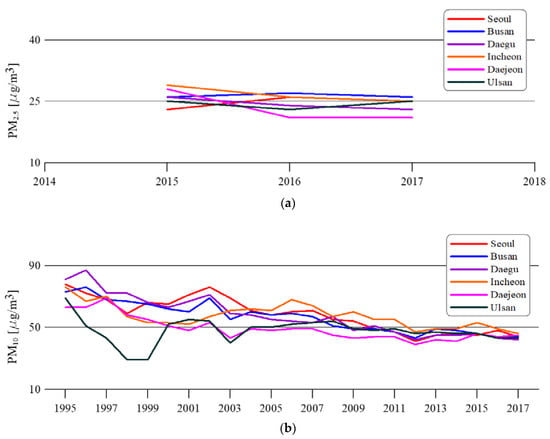
Figure 1.
Annual average concentration of fine particulate matter (PM) in South Korea (a) PM2.5 concentration (b) PM10 concentration [12].
A few decades ago, researchers proposed vegetation strategies regarding controlling pollutant emissions and these had an effect on the indoor environment in a passive way based on the adsorption of fine PM through the surface of the plant leaves [1,19,20]. However, the existing vegetation-type fine PM removal system is not effective due to its passive properties in outdoor applications that require large amounts of air purification [21,22,23,24,25]. Recently, in order to reduce the outdoor fine PM in urban public spaces, tower type air purifiers were introduced and operated on a pilot basis in several countries such as Germany, the Netherlands, and China. For example, V. Splittgerber and P. Saenger [26] analyzed the city tree, which was designed and developed in 2014 by Green City Solutions to solve the problem of urban air pollution, as shown in Figure 2a. This solution is based on a vegetation filter using a passive plant purification and water supply device. It has a filtration area of 3 m in width and 4 m in height and the company claimed that it absorbs 250 g of particles daily. This performance is equivalent to the existence effect of 275 trees in a 1-m radius, and making this a novel device for reducing air pollution. In another analytical study, S. Laxmipriya et al. [27] and R.A. ROOS [28] examined the smog-free tower which was developed in the Netherlands to remove large amounts of air pollution in urban public spaces, as shown in Figure 2b. It is a 23-ft-tall tower and can clean 30,000 cubic meters of air per hour, with a power consumption of 1700 Watts. The tower is known to collect PM2.5 at about 25 percent within a radius of 10 m and release clean air around the tower. The tower has the advantage of being able to remove a large amount of outdoor fine PM by an electrostatic precipitation method, but also has a disadvantage in that a relatively large amount of electrical energy is consumed by corona charging. K. Januszkiewicz and K.G. Kowalski. [17] and D. Cyranoski [29] also studied the China air purification tower built in Xi’an, China, which is 60 m high, as shown in Figure 2c. This tower can collect PM2.5 at about 15 percent within a radius of 1.8 km. Due to the stack effect caused by the height of the tower, outdoor fine PM moves from the bottom of the tower to the top due to the density difference and is purified by the filter installed at the bottom.
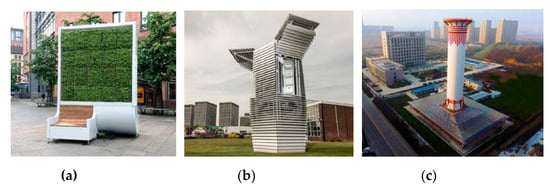
Figure 2.
Existing technology of tower type air purifiers: (a) city tree; (b) smog free tower; (c) China air purification tower.
Such air purification towers installed outdoors to remove fine PM are based on passive air purification systems by the adsorption of fine PM through the surface of plant leaves and active air purification systems using electrostatic precipitators (ESPs). It is noted that they are required to develop a compact and an effective outdoor-type fine PM removal system by considering a limited installation space and an efficient removal amount of fine PM.
In the present study, a novel design hybrid air purification system is introduced using a vegetation soil filter and an electrostatic precipitator (ESP) filter to purify outdoor large-capacity air. The vegetation soil filter used in our setup is based on air circulation through the soil layers, which is different from the conventional passive air purification system using plant leaves. It consists of various types of planting soils: engineering soil and porous material. The multi-layered soil design is selected to efficiently remove fine PM bypassing the particles into the soil effectively. A highly efficient design for an ESP filter capable of purifying fine PM in a city has been developed. Its fine PM removal performance, according to design conditions for two module systems, has been analyzed by experimental measurements using fine PM concentration sensors and a data processing system. It can be expected that, using the two individual modular systems, fine PM is efficiently removed from a city hotspot.
2. Hybrid Filters and Experimental Methods
Hybrid filters using a vegetation soil filter and an ESP filter have been applied to the air purification system. Each filter characteristic and experiment method are as follows.
2.1. Vegetation Soil Filter
A vegetation soil filter with the leaves of plants introduced in the present study can absorb fine PM from the atmosphere to the soil. As shown in Figure 3, this soil filter has a multi-layered structure of vegetation (grass or moss), engineering soil, and porous material from the upper layer. The so-called active system is used in this study to filter the particles from the outside through not only the leaves of the plant, but also through the multi-layered soil in order to improve the air purification effect. A suction-type blower was used for air intake into the soil, and there is a pumping device for the water supply of plants.
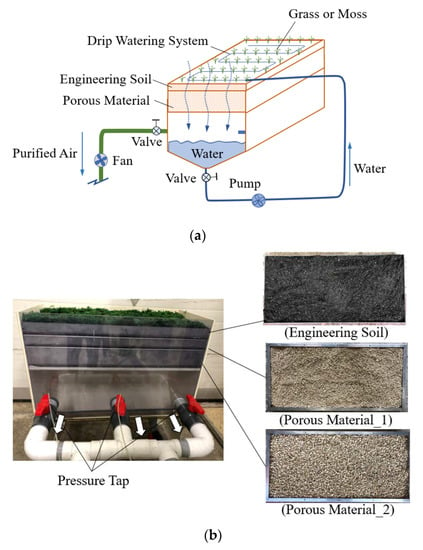
Figure 3.
Vegetation soil filter: (a) schematic view; (b) soil layers.
Table 1 shows the width, length, and height of the engineering soil and two types of porous material. The engineering soil was composed of a composite soil containing silt, and the two types of porous materials used pearlite materials with different diameters [30,31].

Table 1.
Design specification of the vegetation soil filter.
2.2. Electrostatic Precipitator (ESP) Filter
The ESP filter is introduced to effectively process large-scale outdoor fine PM. As shown in Figure 4, the ESP filter charges the particles by high-voltage corona discharge from the discharge electrode (DE) [32,33]. At this time, the emitted electrons are attached to particles and polarized to a negative electrode. Hence, the charged particles are attached to the collecting electrode (CE) opposite to the anion by an electrostatic force [34,35,36,37].

Figure 4.
Electrostatic precipitator (ESP) filter configuration and particle collection process: (a) perspective view of the ESP filter; (b) particle collection process.
Figure 5 shows the schematic view and core parts of the ESP filter system used in this paper. The ESP filter was developed jointly with KC Cottrell in South Korea and consists of two units of 250 cells and 500 cells. For the charging of particles through corona discharge, a high voltage generator of 10 kV or more was installed in conjunction with the ESP filter. In order to introduce fine PM into the ESP cell, a suction blower was installed on the downstream side of the ESP filter and the inlet velocity of inflow air was controlled by the motor rotational speed using an inverter. In this study, the inlet air velocity through the ESP cell was set to 1–3 m/s.

Figure 5.
ESP filter system: (a) schematic view; (b) core parts.
2.3. Experimental Apparatus and Method
In the present study, we developed an air purification system to be installed in a fine PM hotspot in the city. This study intends to analyze and evaluate the performance characteristics of the vegetation soil and ESP filters, which are core modules that directly remove fine PM in the system.
Figure 6 shows the hybrid air purification filter system which consists of the vegetation soil and ESP filters. The test facility is designed to experimentally evaluate individual performance characteristics by installing the core parts of the system. It consists of a control system and measuring sensors of fine PM concentration in addition to a flow rate and a pressure measurement device, as shown in the figure.
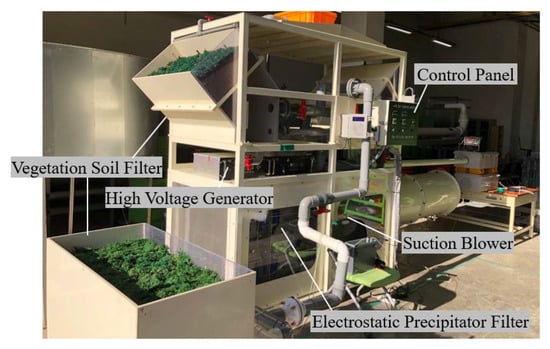
Figure 6.
Hybrid air purification system.
Figure 7 shows the system configuration and the sensor positions of the hybrid filter system. At the vegetation soil and ESP filters, the fine PM concentration was measured in the upstream of the filter before the filter passed and in the downstream chamber after the filter passed. The measured data were stored in the computer using a data acquisition system. The static pressure (Ps) was measured right after the outlet of each filter. The airflow rate was determined arithmetically by measuring the velocity using a pitot tube downstream of the vegetation and ESP ducts with a duct radius of 33 mm and 287 mm, respectively [38]. Table 2 shows the manufacturers and specifications of the sensors and measurement equipment that were used in this study.

Figure 7.
Sensor positions of the hybrid filter system.

Table 2.
Specifications of main measurement equipment.
Every measurement instrument was calibrated and adjusted to zero before the experiment, and the fine PM concentration was collected as the ensemble average of the values measured four times under each measuring condition.
2.3.1. Analytical Method for the Vegetation Soil Filter
The performance evaluation of the vegetation soil filter was analyzed by changing the air velocity at the filter inlet side from 0.05 m/s to 0.15 m/s. The inlet air velocity is determined by adjusting the rotational speed of the suction blower using an inverter, as shown in Figure 7. Table 3 shows the air velocity at the inlet side of the vegetation soil filter and the rotational speed of the suction blower for generating it. It is noted that the ability of the vegetation soil filter to remove fine PM was analyzed by varying the stacking height of the engineering soil and porous materials. In order to analyze the removal performance of fine PM according to the stacking height of the filter, the heights of the vegetation soil filters, combining engineering soil and porous material layers as shown in Table 1, were set to three types: 250 mm, 200 mm, 150 mm. The inlet air velocity changes linearly with the rotational speed of the suction blower in the vegetation soil filter at the height of 200 mm, as shown in Figure 8.

Table 3.
Inlet air velocity of the vegetation soil filter.
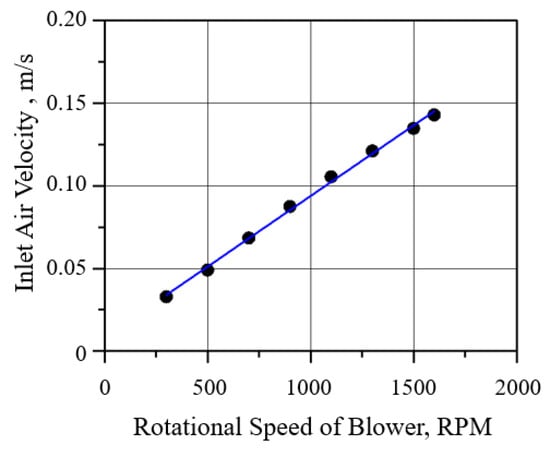
Figure 8.
Inlet air velocity with respect to the rotational speed of suction blower (rpm) in the vegetation soil filter at a height of 200 mm.
Figure 9 shows the pressure drop with respect to the inlet air velocity for three stacking heights of the vegetation soil filter. It is noted that the pressure drop is influenced by the difference in density due to the change in the inlet air velocity and the inlet air temperature [39], and the inlet air temperature in the present study is 15 degrees Celsius. As shown in the figure, the pressure increases as the inlet air velocity increases and it also increases as the stacking height of the soil increases. The rotational speed of the suction blower corresponds to inlet air velocity, as shown in Table 3.
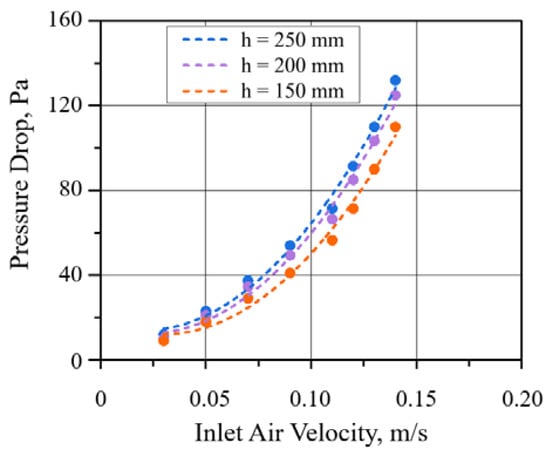
Figure 9.
Pressure drop (resistance) with respect to the inlet air velocity for three stacking heights of the vegetation soil filter.
2.3.2. Analytical Method for the Electrostatic Precipitator (ESP) Filter
The performance of the ESP filter was analyzed by changing the inlet air velocity on the ESP filter. The inlet air velocity of the filter is between 1 m/s and 3 m/s when adjusting the rotational speed of the rotor by installing an inverter in the suction blower. The inlet air velocity at the upstream of the ESP filter also linearly increases as the rpm of the blower increases as shown in Figure 10a, which is similar to the vegetation soil filter. The inlet air velocity of the ESP filter used to evaluate the performance of the ESP filter in the present study is 1, 2, 3 m/s, and the corresponding rpm of the blower is shown in Table 4. As shown in Figure 10b, it is noted that the pressure applied due to the increase in the air passage velocity of the ESP filter charging plate increases with a secondary curve.
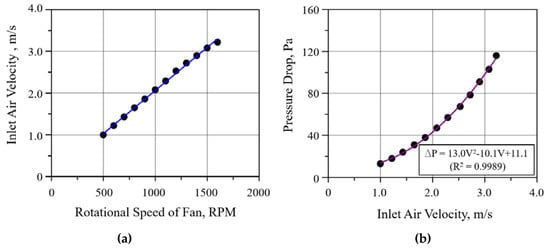
Figure 10.
Pressure drop of the ESP filter; (a) inlet air velocity vs. rpm of suction blower; (b) pressure drop vs. inlet air velocity at the upstream of the ESP filter.

Table 4.
Inlet air velocity of the ESP filter.
3. Results and Discussion
The present study describes a hybrid air purification system that consists of two filter systems: a vegetation soil filter and an ESP filter. For each filter system, the reduction characteristics of fine PM concentrations were experimentally analyzed while changing the stacking height of the soil filter and the inlet air velocity at the upstream of the two filters. Based on the database constructed by the present experiments, the authors intend to design an air purification tower for fine PM reduction effectively, in a city where the fine PM concentration is predicted to be high in the future.
3.1. Fine Particulate Matter (PM) Reduction Effect of the Vegetation Soil Filter
Figure 11 shows the reduction rate of PM2.5 and PM10 for the vegetation soil filter at the three soil stacking heights. Solid black dots in the figure represent the fine PM reduction rate obtained by measuring each concentration. In order to evaluate the performance of the filter, the fine PM reduction rate based on its concentration measured at the upstream and the downstream of the filter was introduced, and the definition formula is as follows.
where PMup and PMdown are the fine PM concentrations measured at the upstream and the downstream of the filter respectively.
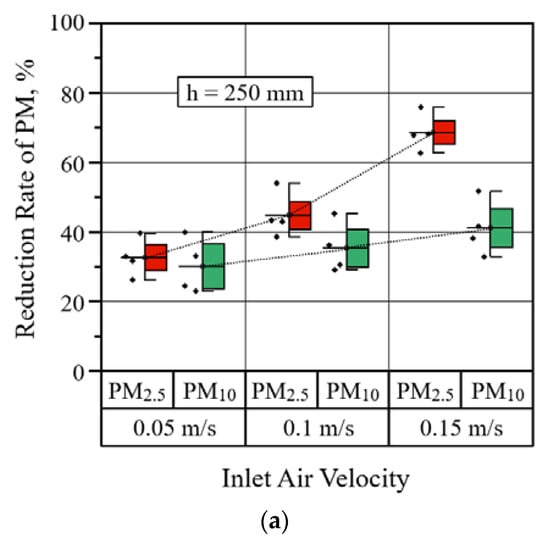
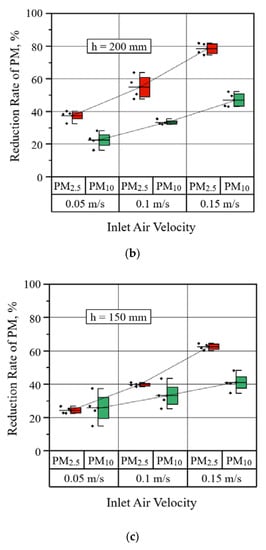
Figure 11.
Reduction rate values of PM2.5 and PM10 for the vegetation soil filter at the three soil stacking heights: (a) 250 mm; (b) 200 mm; (c) 150 mm.
As shown in Figure 11, the effect of fine PM reduction applied with the vegetation soil filter increases irrespective of the fine PM and the stacking height of the soil as the inlet air velocity increases. The inlet air velocity of the vegetation soil filter is limited to a maximum of 0.15 m/s in this study considering the survival conditions and soil drying of vegetation such as moss and grass. In addition, it can be seen that regardless of the stacking height of the vegetation soil filter, PM2.5 is more effective in the fine PM reduction rate under all the inlet air velocity conditions compared to PM10.
In the inlet air velocity of 0.15 m/s where the fine PM reduction rate has the highest value, measuring data range and mean value of the fine PM reduction rate with respect to the stacking height of the vegetation soil filter are summarized in Table 5. It is noted that the mean value of the fine PM reduction rate is derived from the ensemble average of the measured data for four days. The maximum error is observed at a stacking height of 250 mm, and the maximum error is 9.5 percent with respect to the averaged data.

Table 5.
Mean value of the fine PM reduction rates for the vegetation soil filter at an inlet air velocity of 0.15 m/s.
Figure 12 shows the mean reduction rate of PM2.5 and PM10 for the three stacking heights of the vegetation soil filter at the inlet air velocity of 0.15 m/s where the velocity has the highest fine PM reduction rate compared to the other ones. From the figure, it is clear that the mean reduction rate of fine PM is the best for both PM2.5 and PM10 when the stacking height of the vegetation soil filter is 200 mm.
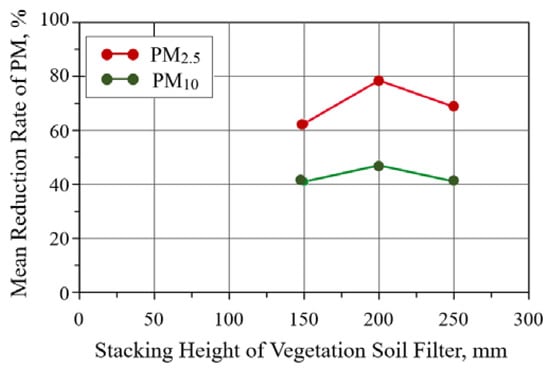
Figure 12.
Mean reduction rate of PM2.5 and PM10 for the three stacking heights of the vegetation soil filter at the inlet air velocity of 0.15 m/s.
3.2. Fine PM Reduction Effect of the ESP Filter
In order to remove a large amount of outdoor fine PM, the fine PM reduction effect has been analyzed using a highly efficient ESP cell designed and fabricated by itself. Unlike the vegetation soil filter, the fine PM reduction effect in both PM2.5 and PM10 decreases as the inlet air velocity of the ESP filter increases as shown in Figure 13. While there is no significant difference in the fine PM reduction rate of both PM2.5 and PM10, but it can be seen that PM10 reduction rate is relatively high. This is because each particle of PM10 is relatively well charged with a high voltage compared to PM2.5, which means that it is advantageous for larger particles to be charged by high-voltage corona discharge from the discharge electrode, as shown in Figure 4. It is no use to say that more charged particles are apt to attach the particle collecting plate easily. This tendency is different from that of the vegetation soil filter.

Figure 13.
Reduction rate values of PM2.5 and PM10 for the ESP filter.
Table 6 shows the mean reduction rate of fine PM under the condition that the inlet air velocity is 3 m/s for the consideration of mass air purification in an outdoor space in a city hotspot.

Table 6.
Mean reduction rates for the ESP filter at an inlet air velocity of 3 m/s.
As a result of analyzing the fine PM reduction effect using a vegetation soil filter and an ESP filter manufactured with a modular system, it is found that PM2.5 has a reduced rate of 70 percent or more. Considering the fact that small particle-like PM2.5 can penetrate into the alveolar wall deep inside the lungs through breathing and invokes many adverse effects on health, it is a great indication that the capability of our system of effectively removing PM2.5 is verified empirically.
4. A Possible Future Application of the Hybrid Air Purification System to the City Hotspot
Based on the research results on the vegetation soil filter and the ESP filter, the authors plan to install an air purification tower consisting of the two filters vertically in a city hotspot. Urban multi-living spaces, bus stops/roadsides, and fine PM concentrations in downtown areas are considered as hotspots. Kim et al. analyzed the hotspot emission areas in Seoul, South Korea, and considered the hotspots as mobile pollution areas, non-industrial combustion areas, bio-combustion areas, and contaminated areas that generate the scattering of fine PM as shown in Figure 14.
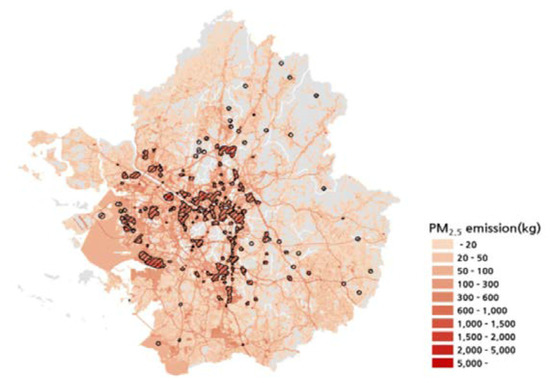
Figure 14.
Maps of PM2.5 hotspot emission areas in Seoul metropolitan area, South Korea [39].
Figure 15 shows the air purification tower consisting of vegetation soil filters and ESP filters, which is the hybrid system that combines two ESP filters and 20 vegetation soil filters. The ESP filters are installed at the bottom of the air purification tower to purify a large amount of contaminated air, and the vertical tower consists of 5 stories of vegetation soil filters, resulting in a total tower height of about 7m. A solar panel is installed on the roof of the tower, and it is designed to be independent of partial operating energy as shown in Figure 15a. Continuous operation for one day (24 h) using one air purification tower can purify a contaminated outdoor air amount of approximately 650,000 cubic meters, as shown in Table 7. That is, it is possible to supply clean air to 41,500 adults on a daily basis with one air purification tower installed at the hotspot. The daily consumption of electrical energy is about 150 kWh, and some can be replaced with solar power. Considering the operating conditions of the ESP filter, which is operated only in an intensive generation zone of fine PM, such as the commuting time during the day, the operating energy cost per day can be reduced. The energy consumption of the vegetation soil filter is 10 kWh even after continuously operating for 24 h a day, so it can greatly contribute to the green city environment. Figure 15b shows a schematic diagram of the air purification tower installed in a city hotspot. As shown in the figure, air purification towers installed in city hotspots are said to be highly useful as air purification systems in a multi-use space, as well as resting places for citizens by providing a green urban environment.
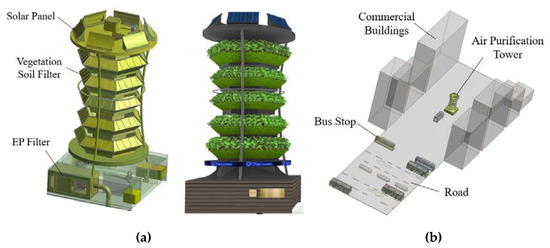
Figure 15.
Perspective view of the hybrid air purification system installed at the city hotspot: (a) hybrid air purification tower; (b) an example of installing the tower in a hotspot area.

Table 7.
Air purification capacity of the hybrid air purification tower per day.
5. Conclusions
The present study describes a hybrid air purification system consisting of vegetation soil filters and ESP filters to enhance the removal efficiency of fine PM. The vegetation soil filter with multi-layered artificial soils has been newly designed with an active removal method to effectively remove high-concentration fine PM through the soil passage, while the ESP filter has been designed to remove large amounts of outdoor fine PM. For each filter system, the reduction characteristics of the fine PM were experimentally analyzed while changing the stacking height of the soil filter and the inlet air velocity at the upstream of the two filters. The results are summarized as follows:
- (1)
- The removal effect of fine PM to the vegetation soil filter increases as the inlet air velocity increases for PM2.5 and PM10. The inlet air velocity of the vegetation soil filter is limited to a maximum of 0.15 m/s considering the survival conditions and soil drying of vegetation such as moss and grass.
- (2)
- The stacking height of the vegetation soil filter, which is determined by the artificial soil and the porous soil layer, correlates with the pressure resistance according to the air flow inside the soil and the soil adsorption capacity of the fine PM. In the present vegetation soil filter, the fine PM reduction rate is the best when the stacking height of the vegetation soil filter is 200 mm.
- (3)
- For the ESP filter, as the inlet air velocity of the ESP filter increases, the fine PM reduction effect decreases, unlike the vegetation soil filter. PM10 is a relatively high reduction rate for the ESP filter because PM10, which has a relatively large particle size, is well charged with a high voltage compared to PM2.5, and thus the amount attached to the particle collecting plate is also relatively large.
- (4)
- Considering the fact that small particle-like PM2.5 can enter the lungs through breathing and invokes many adverse effects on health, it is important to develop an efficient removal filter of PM2.5. Throughout the analysis of the fine PM reduction effect using a vegetation soil filter and an ESP filter, it is found that PM2.5 has a reduced rate of 70 percent or more.
- (5)
- Based on these research results for the vegetation soil filter and the ESP filter, it is possible to install an air purification tower consisting of the two filters vertically in a city hotspot. A hybrid tower that combines two ESP filters and 20 vegetation soil filters can purify a contaminated outdoor air amount of approximately 650,000 cubic meters in one day. It is noted that the hybrid air purification system maximizes the effects of green spaces in urban areas, which is an amazing solution to solve the outdoor air pollution problem.
- (6)
- Installing one air purification tower in a hotspot can purify a contaminated outdoor air amount of approximately 650,000 cubic meters and is capable of supplying clean air to 41,500 adults per day.
Author Contributions
All data were collected and analyzed by A.E., who also devised the methodology and wrote the manuscript. C.-M.J. provided his guidance and supervision for this study. All authors have read and agreed to the published version of the manuscript.
Funding
This work was supported by the National Research Foundation of Korea (NRF) grant funded by the Korea government of Ministry of Science and ICT (MSIT) and Ministry of Education (MOE) [grant number 2019M3E7A1113096].
Acknowledgments
We would also like to thank Son, S.W., for helping us perform the air purification tower performance test.
Conflicts of Interest
The authors declare no actual or potential conflicts of interest.
References
- El Mokadem, A.A.F.; Eleinen, O.M.A.; Megahed, N.A.; Hassan, A.M. Analytical Trends of Building Morphology as a Passive Strategies to Promote Outdoor Air Quality. IJIRSET 2019, 8, 6944–6952. [Google Scholar]
- Lu, D.; Xu, J.; Yue, W.; Mao, W.; Yang, D.; Wang, J. Response of PM2. 5 pollution to land use in China. J. Clean. Prod. 2020, 244, 118741. [Google Scholar] [CrossRef]
- Kim, J.Y.; Yoo, J.Y.; Park, C.J. Recent Status and Policy of Fine Dust in the Metropolitan Area of Korea. Int. J. Environ. Sci. Dev. 2018, 9, 183–186. [Google Scholar] [CrossRef]
- Liang, C.-S.; Duan, F.-K.; He, K.-B.; Ma, Y.-L. Review on recent progress in observations, source identifications and countermeasures of PM2. 5. Environ. Int. 2016, 86, 150–170. [Google Scholar] [CrossRef] [PubMed]
- Park, S.; Kim, S.; Lee, J. A Pilot Study on the Relationship between Urban Green Spaces and Fine Particulate Matter. Int. J. Geospat. Environ. Res. 2020, 7, 1–3. [Google Scholar]
- Lin, Y.; Zou, J.; Yang, W.; Li, C.-Q. A review of recent advances in research on PM2. 5 in China. Int. J. Environ. Res. Public Health 2018, 15, 438. [Google Scholar] [CrossRef]
- Kang, D.; Kim, J.-E. Fine, ultrafine, and yellow dust: Emerging health problems in Korea. J. Korean Med. Sci. 2014, 29, 621–622. [Google Scholar] [CrossRef]
- Pui, D.Y.; Chen, S.-C.; Zuo, Z. PM2. 5 in China: Measurements, sources, visibility and health effects, and mitigation. Particuology 2014, 13, 1–26. [Google Scholar] [CrossRef]
- Amato, F.; Querol, X.; Johansson, C.; Nagl, C.; Alastuey, A. A review on the effectiveness of street sweeping, washing and dust suppressants as urban PM control methods. Sci. Total Environ. 2010, 408, 3070–3084. [Google Scholar] [CrossRef]
- Martins, N.R.; da Graça, G.C. Impact of PM2. 5 in indoor urban environments: A review. Sustain. Cities Soc. 2018, 42, 259–275. [Google Scholar] [CrossRef]
- Park, S.-H.; Ko, D.-W. Investigating the effects of the built environment on PM2. 5 and PM10: A case study of Seoul Metropolitan city, South Korea. Sustainability 2018, 10, 4552. [Google Scholar] [CrossRef]
- Air Korea, Korea Environment Cooperation. Annual Air Quality Trends. Available online: https://www.airkorea.or.kr/eng/annualAirQualityTrends?pMENU_NO=161 (accessed on 1 May 2020).
- Kim, J.-H.; Kim, H.-J.; Yoo, S.-H. Public value of enforcing the PM2. 5 concentration reduction policy in South Korean urban areas. Sustainability 2018, 10, 1144. [Google Scholar] [CrossRef]
- Lee, S. Korea’s New Comprehensive Plan on Fine Dust and Its Implications for Policy and Research. Res. Brief 2018, 29, 1–7. [Google Scholar]
- Lee, M. An analysis on the concentration characteristics of PM2. 5 in Seoul, Korea from 2005 to 2012. Asia-Pac. J. Atmospheric Sci. 2014, 50, 585–594. [Google Scholar] [CrossRef]
- World Health Organization. Ambient (Outdoor) Air Pollution. Available online: https://www.who.int/en/news-room/fact-sheets/detail/ambient-(outdoor)-air-quality-and-health (accessed on 5 May 2020).
- Januszkiewicz, K.; Kowalski, K.G. Air purification in highly-urbanized areas with the use of TiO2. New approach in designing urban public space with beneficial human condition. In Proceedings of the IOP Conference Series: Materials Science and Engineering, Pergue, Czech Republic, 17–21 June 2019. [Google Scholar]
- Lu, Z.; Wei, Z.; Li, Q.; Wang, H. Numerical Simulation of Dust Deposition in the Filter Tube of Adsorption Air Purifier. Math. Probl. Eng. 2019, 2019. [Google Scholar] [CrossRef]
- Viecco, M.; Vera, S.; Jorquera, H.; Bustamante, W.; Gironás, J.; Dobbs, C.; Leiva, E. Potential of particle matter dry deposition on green roofs and living walls vegetation for mitigating urban atmospheric pollution in semiarid climates. Sustainability 2018, 10, 2431. [Google Scholar] [CrossRef]
- Liu, G.; Xiao, M.; Zhang, X.; Gal, C.; Chen, X.; Liu, L.; Pan, S.; Wu, J.; Tang, L.; Clements-Croome, D. A review of air filtration technologies for sustainable and healthy building ventilation. Sustain. Cities Soc. 2017, 32, 375–396. [Google Scholar] [CrossRef]
- Chen, L.; Liu, C.; Zou, R.; Yang, M.; Zhang, Z. Experimental examination of effectiveness of vegetation as bio-filter of particulate matters in the urban environment. Environ. Pollut. 2016, 208, 198–208. [Google Scholar] [CrossRef]
- Perini, K.; Ottelé, M.; Giulini, S.; Magliocco, A.; Roccotiello, E. Quantification of fine dust deposition on different plant species in a vertical greening system. Ecol. Eng. 2017, 100, 268–276. [Google Scholar] [CrossRef]
- Janhäll, S. Review on urban vegetation and particle air pollution–Deposition and dispersion. Atmospheric Environ. 2015, 105, 130–137. [Google Scholar] [CrossRef]
- Litschke, T.; Kuttler, W. On the reduction of urban particle concentration by vegetation—A review. Meteorologische Zeitschrift 2008, 17, 229–240. [Google Scholar] [CrossRef]
- Qin, H.; Hong, B.; Jiang, R.; Yan, S.; Zhou, Y. The Effect of Vegetation Enhancement on Particulate Pollution Reduction: CFD Simulations in an Urban Park. Forests 2019, 10, 373. [Google Scholar] [CrossRef]
- Splittgerber, V.; Saenger, P. City Tree: A Vertical Plant Wall. Air Pollut. XXIII 2015, 295, 295–298. [Google Scholar]
- Laxmipriya, S.; Kumar, A.A.; Aravinthan, S.; Arunachalam, N. Reduction of Air Pollution Using Smog-free-tower a Review Paper. IRJAET 2018, 4, 3251–3255. [Google Scholar]
- ROOS, R.A. The Smog Free Tower «Solution» of Daan Roosegaard. Available online: https://www.studioroosegaarde.net/project/smog-free-tower (accessed on 15 May 2020).
- Cyranoski, D. China tests giant air cleaner to combat smog. Nature 2018, 555, 7695. [Google Scholar] [CrossRef]
- Lee, L.S.; Jim, C.Y. Thermal-cooling performance of subtropical green roof with deep substrate and woodland vegetation. Ecol. Eng. 2018, 119, 8–18. [Google Scholar] [CrossRef]
- Markoska, V.; Spalevic, V.; Gulaboski, R. A Research on the Influence of Porosity on Perlite Substrate and its Interaction on Porosity of Two Types of Soil and Peat Substrate. Poljoprivreda i Sumarstvo 2018, 64, 15–29. [Google Scholar] [CrossRef]
- Altun, A.F.; Kilic, M. Utilization of electrostatic precipitators for healthy indoor environments. In Proceedings of the E3S Web of Conferences, Bucharest, Romania, 26–29 May 2019. [Google Scholar] [CrossRef]
- Day, D.; Xiang, J.; Mo, J.; Clyde, M.; Weschler, C.; Li, F.; Gong, J.; Chung, M.; Zhang, Y.; Zhang, J. Combined use of an electrostatic precipitator and a high-efficiency particulate air filter in building ventilation systems: Effects on cardiorespiratory health indicators in healthy adults. Indoor Air 2018, 28, 360–372. [Google Scholar] [CrossRef]
- Huang, Y.; Li, S.; Zheng, Q.; Shen, X.; Wang, S.; Han, P.; Liu, Z.; Yan, K. Recent progress of dry electrostatic precipitation for PM2. 5 emission control from coal-fired boilers. Int. J. Plasma Environ. Sci. Technol. 2015, 9, 69–126. [Google Scholar]
- Xiang, J.; Weschler, C.J.; Mo, J.; Day, D.; Zhang, J.; Zhang, Y. Ozone, electrostatic precipitators, and particle number concentrations: Correlations observed in a real office during working hours. Environ. Sci. Technol. 2016, 50, 10236–10244. [Google Scholar] [CrossRef]
- Poppendieck, D.G.; Rim, D.; Persily, A.K. Ultrafine particle removal and ozone generation by in-duct electrostatic precipitators. Environ. Sci. Technol. 2014, 48, 2067–2074. [Google Scholar] [CrossRef] [PubMed]
- Feng, Z.; Yang, J.; Zhang, J. Numerical optimization on newly developed electrostatic enhanced pleated air filters for efficient removal of airborne ultra-fine particles: Towards sustainable urban and built environment. Sustain. Cities Soc. 2020, 54, 2–4. [Google Scholar] [CrossRef]
- Pieve, M.; Salvadori, G. Performance of an air-cooled steam condenser for a waste-to-energy plant over its whole operating range. Energy Convers. Manag. 2011, 52, 1908–1913. [Google Scholar] [CrossRef]
- Kim, D.; Choi, M.; Yoon, B. Analysis of PM hot-spot emission zone in Seoul metropolitan area. J. Korean Soc. Atmospheric Environ. 2019, 35, 476–501. [Google Scholar] [CrossRef]
© 2020 by the authors. Licensee MDPI, Basel, Switzerland. This article is an open access article distributed under the terms and conditions of the Creative Commons Attribution (CC BY) license (http://creativecommons.org/licenses/by/4.0/).




